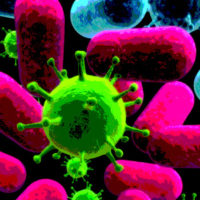Successful Sampling Part I: Essential Approaches

When I first started on my doctoral dissertation and began assembling my lab equipment somewhere in the bowels of a University of Minnesota health sciences building, some benefactor give me a yellowed-with-age, shopworn sign with an admonishment that read: “Garbage in, Garbage out” (in an elegant, illuminated medieval script). It served me well for the time I was there, and in keeping with tradition, I passed it on to the next lab denizen. This phrase has often come to mind during the last two decades while working as a sanitarian, and each time it seems to find a new meaning. I have come to appreciate how this simple phrase applies to quality control (QC) and food safety, and particularly, how it guides the successes, failures and various misadventures in the art and science of sampling.
Every time we monitor the critical points of a Hazard Analysis and Critical Control Points (HACCP) program, conduct a regulatory inspection or compliance audit, validate a cleaning procedure, or take products for quality control analyses, we sample. The act of sampling is really a sequence of events that, when done correctly, gives us a reasonable assurance that our actions have prevented foodborne illnesses. However, all too often we go through the formality of sampling without understanding the principles behind it. When this happens, we often miss something important and tend to shrug it off with an explanation bordering on the extra-rational such as fate, the unlucky celestial doggy, misalignment of the moon or just bad ju-ju. We then blindly resample using the same strategy that got us into that predicament in the first place, hoping for better results. By simply going through a series of logical steps, we can replace the ambiguity with reason and be assured that what we’ve found is really so.
The Wheres and Whens of Sampling
The word “sampling” implies that the action has an objective. That objective is to produce a set of samples representative of the source under investigation, and if possible, suitable for subsequent analysis. The sample itself is a representative part of the subject to be analyzed and chosen so that it has the same qualities or properties as the materials under consideration. Samples that are not representative of the source are of little use. And, poor collection procedures contribute to the uncertainty of the analytical results. In other words: Garbage in, garbage out!
Carrying this idea a bit further, it is safe to say that sampling and analytical errors occur independently of each other. Regardless of how exacting the analytical methodology is, if the sampling method is flawed, the results are likewise tainted. It is definitely easier to fix analytical errors than to remedy sampling errors. Therefore, to ensure confidence in our sampling program, I would like to take one step back and review some of the basics by asking a series of questions. (By the way, to have a successful sampling program, each question is linked to the other with an “and,” not an “or.”)
Why collect the samples? In my case and that of my fellow environmental health professionals, we want to validate our observations that the food sold to the public is produced, transported, stored, prepared or served in a manner to minimize the risk of foodborne illness. We primarily use thermometry, among other sampling methodologies, to ensure compliance with the U.S. Food and Drug Administration (FDA) Food Code. Every time we place our thermocouple probe into some food product, we are sampling. We also take food samples for subsequent analysis to verify product purity, safety and conformance to regulations. We collect a series of samples to identify any deviation at a critical control point, including but not limited to environmental hygiene samples to verify sanitation standards and air samples to determine potential public health hazards.
What types of samples are needed? For the sanitarian, most types of samples are determined by the definition, or rather definitions, of “potentially hazardous food.” In our profession, we run the gamut from taking whole food samples to check for purity, to the simple monitoring of physical characteristics, such as temperature, water activity and pH. We sample for equipment and facility cleanliness and sanitization, where we use surrogates such as chlorine or quaternary ammonium concentrations to extrapolate to our definition of sanitization. Sampling for cleanliness can require an entirely different set of data; some bordering on subjective (i.e., clean to sight and touch) and others entirely more objective (environmental hygiene monitoring swabs, sponges, ATP luminometers, air samplers, etc.). Ultimately, the type of sample will determine the answers to the next questions.
What sampling strategy will be used? This is probably the one question that requires the most concise answer to ensure a successful sampling program. It also is the most misunderstood and overlooked question. The short answer is that sampling methods are classified as either probability or nonprobability. Probability methods include random sampling and systematic sampling, whereas nonprobability sampling makes non-random sample selections. The types and number of samples and the sampling frequency determine the sampling strategy.
Let us begin with the nonprobability sampling strategies. In these, the sampling error cannot be calculated and remains unknown. This is significant to the interpretation of the data derived from these types of sampling schemes. Nonprobability sampling data is difficult to interpret and may make the person taking the sample particularly vulnerable to error. Even so, each nonprobability sampling strategy has a proscribed set of rules that are determined by the situation and may be quite valid if justified. For instance:
• Convenience sampling is used in an exploratory manner, when we are interested in getting an inexpensive approximation of the truth. As the name implies, the samples are selected because they are convenient. Although this strategy is quite acceptable as a screening tool, it also is useful to get a gross estimate of the results and to design a more comprehensive sampling strategy. Unfortunately, convenience sampling is all too often erroneously used as the final arbiter in regulatory inspections.
• Judgmental sampling strategy relies upon experience and available information. It is used where the contamination source or risk factor is known. Because it uses the fewest samples and relies on quasi-subjective criteria, it introduces the greatest amount of bias into the sampling strategy, and therefore, cannot be repeated for validity. While there is no argument in taking a sample of food that is implicated in a foodborne illness, I have seen this sampling strategy misused in compliance and QC to a point of embarrassment. I would like to have a nickel for every pound of good food that was destroyed because of poor judgmental sampling (aka bias). I strongly believe that if we are to rely on this strategy, one without objectivity, it is our obligation to justify its use in writing with each sample or set of samples.
• There is a third special version of nonprobability sampling that we use upon occasion. It is known as “snowball sampling,” a name that comes to us from biometricians who conduct population surveys. It is used when the desired sample characteristic is rare. It’s like rummaging through the tackle box for a jig that might catch fish. For want of a better description, snowball sampling relies on “referrals,” or outliers. We use it in cases where the odd sample may point us in the direction of another problematic food safety issue. By its very nature, it introduces the most bias and should only be used as a screening tool. This sampling strategy should never be relied on as a definitive indicator in compliance or quality audits.
In the probability sampling strategies, each sample has a known non-zero probability of being selected. The two most widely used strategies are systematic and random. These are the preferred schemes for the type of sampling conducted in our area of interest.
• Systematic sampling strategy relies on experience and available information, but it is used to find gradients: time, space or physical conditions. It more closely conforms to a random approach. Systematic sampling requires a consistent grid or pattern. To illustrate, imagine a 4-inch hotel pan of lasagna set out for service. To accurately measure the temperature of the food, draw an imaginary line diagonally across the pan and take temperature readings with a thermocouple probe every three or four inches. This will not only give an accurate representation of the internal temperature, but also will indicate the rate of cooling. Although this strategy introduces some bias, more samples are required than in nonprobability sampling, thereby ensuring results more characteristic of the actual sample. As a side note: Systematic sampling is the only way to accurately validate a warewashing machine. Using a 15-foot dishwasher K-probe with a digital thermometer, pass the probe through the machine while it is in operation; taking readings every five seconds. Both time and temperature are recorded for the wash, rinse and sanitizing cycles.
• Random sampling strategies depend on the theory of random chance probabilities to choose the most representative sample. It is also the least understood and least frequently used by regulators. Pity. Random sampling virtually eliminates bias and is therefore the strategy of choice if an issue is contentious or may pose a serious risk of illness. But it comes with a price. It requires the greatest number of samples; the lot size or area to be sampled must be known, pre-sampling preparation and coordination are both time-consuming and meticulous. The good news is that once the concept is understood, it is relatively easy to apply to most situations, even preferentially replacing judgmental and systematic strategies whenever practical. If in my practice as a regulator, I am to cite a serious violation relating to food safety, particularly if a large amount of food is involved, I had best consider a random sampling strategy to justify my actions.
What number and frequency of samples are required? Somewhere along the line, I learned a rule-of-thumb regarding the number of samples. Unfortunately, I cannot recall the reference or the professor who told it to me. It goes like this: For statistical relevance, at least five samples are needed, but rarely more than 25 are needed. This served me well until I learned about a simple statistical scheme for any sample size and that is easy enough for anyone to use. I first learned about it while working for the U.S. Department of Agriculture (USDA). Their quality assurance folks regularly used the Military Standard for Sampling Procedures and Tables for Inspection by Attributes (MIL-STD-105E, 10 May 1989). This has since been replaced by a standard of the same name: ANSI/ASQ Z1.4-2003 and its companion standard: Sampling Procedures and Tables for Inspection by Variables for Percent Nonconfoming: ANSI/ASQ Z1.9-2003. Both standards are published by the American Society for Quality (www.asq.org). These standards have easy-to-understand definitions and instructions to lead you through the sampling process. The only other tool needed is a table of random numbers—for use with the random strategy—that is readily available free at any library or online. There are even easy-to-follow instructions on how to generate and use a random number table using the MicroSoft Excel program. One certainly does not have to be a statistician to appreciate the simplicity of the prescribed approaches of the ANSI/ASQ standards.
To give this question finality, somewhere along the line we have to deal with the number of sample controls to assure the accuracy of our data. I use another rule-of-thumb that has served me well. This rule calls for one to three controls for each sample, where applicable. For example, one control is sufficient if the source of contamination or deviation from the regulations is obvious; where the source of contamination is unknown, three control samples will provide a significant degree of confidence. This concept even applies to regulatory sampling and is basically used as an adjunct to the plan review, to determine if the facilities can meet temperature demands. In this instance, the controls serve as a validation tool for equipment capabilities.
What types of equipment are needed for sampling? I am a strong believer that the tool should match the situation. We don’t use screwdrivers to drive in nails. Likewise, you can’t use a bimetal dial or an infrared thermometer to measure the internal temperature of a hamburger patty. The sampling equipment must complement the sampling objective. I have been writing on field instrumentation for many years and continue to collect information which I will share in future columns. For the present however, I will leave you with the following list of criteria in selecting portable instruments used for sampling various parameters relating to food safety. Ideally, the instruments should be disposable or easily decontaminated; small, safe, portable and lightweight; rugged and not easily damaged; inexpensive; and easy to read, interpret, calibrate, operate and maintain. Use good judgment, read and follow the instructional manual and do not hesitate to ask your sampling equipment suppliers for assistance when technical questions arise.
Where are the best sampling locations? This is as much an art form as it is science. This question is best answered using common sense and a good knowledge of the mechanisms of cross-contamination. What set me on a course of forensics was watching an individual aseptically sampling food, while contaminating everything around him but his sample. The act of sampling should be carefully choreographed so as not to contaminate other foods or place oneself at risk of injury. While we’re considering location, we must also be aware of the sampling sequence, particularly if we are to validate a HACCP plan. The sampling locations should be selected in sequential order from processed to raw, cleaned to soiled, and sanitized to contaminated.
How will the results be interpreted? Finally, this brings us back to the sampling objective. In presenting the collected data, consider five data quality indicators: precision, bias, representativeness, completeness and comparability. Each of these is sensitive to the manner in which sampling is carried out and is a reflection on the thoroughness of the answers we provided to the foregoing questions. The variability of monitoring data should also be interpreted to reflect consideration of three sources of sampling error. These include sampling design, sampling implementation and sample analysis. This is particularly significant when decisions are made resulting from regulatory inspections.
While we have only scratched the surface in surveying the art and science of sampling, at least it’s a start. In the next two issues of Food Safety Magazine, Parts II and III will detail essential steps in conducting successful air sampling and environmental surface sampling programs in food processing and foodservice facilities.
Forensic sanitarian Robert W. Powitz, Ph.D., MPH, RS, CFSP, is principal consultant and technical director of Old Saybrook, CT-based R.W. Powitz & Associates. Dr. Powitz welcomes reader questions and queries for discussion in upcoming columns, which can be sent to him directly at sanitarian@juno.com or through his website at www.sanitarian.com.
Looking for a reprint of this article?
From high-res PDFs to custom plaques, order your copy today!








.webp?t=1721343192)
